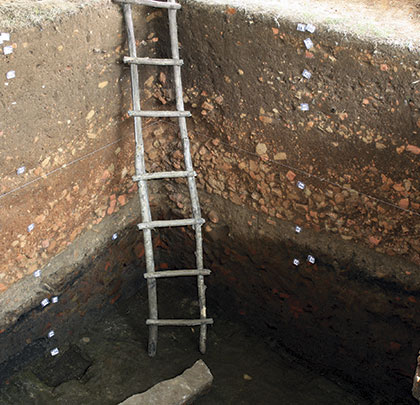The recent discovery of long buried crypts during a routine water main replacement project in New York City’s Washington Square Park should serve as a reminder to developers and their contractors that a review of archaeological records should be an important part of their due diligence prior to beginning construction, according to CBRE Valuation & Advisory Services group.
BELOW THE SURFACE
Archeological finds during construction are not uncommon, especially in urban settings where more than 500 years of American history and thousands of years of Native American relics may lie buried a few feet below the surface.
In the U.S., builders are obligated to report archaeological finds if the project requires a federal, state, or occasionally local permit, license, or funding that triggered compliance with historic preservation laws, according to Cris Kimbrough, PhD, PMP, archaeologist and managing director at CBRE Telecom Advisory Services. If archaeological resources are identified during construction/development for a project that has gone through the federal/state/local historic preservation process, all work must stop until further preservation measures can be determined and completed.
There are few rules governing artifacts that are encountered on private land because U.S. law is focused on the protection of private property. As a consequence, artifacts located in areas where no historic preservation rules are in place are at risk. This does not apply to human remains, however. Human remains always have to be reported to the local authorities and treated appropriately.
RECORDS MAINTAINED
The State Historic Preservation Office (SHPO) maintains records on identified archaeological resources in each state. In addition, museums and colleges/universities may also have records, but these are most often registered with the SHPO or held in lieu of SHPO archaeological files. These files are not accessible to the public and can only be viewed by qualified individuals—usually a qualified archaeologist or other historic preservation specialist.
Most states have a project review process wherein staff at the SHPO reviews the project plans and their files to determine if there are any potential direct or indirect impacts to historic and archaeological resources. If there are, SHPO may request archaeological or other studies be completed prior to construction. Native American tribes also maintain archaeological and other Traditional Cultural Properties (TCP) records, but access to these files is almost always restricted. Tribes are consulted regarding their cultural resources as part of the federal historic preservation process, and most state preservation processes.
THE PRESENCE OF ARTIFACTS
If artifacts are discovered as part of the pre-development review process, then additional archaeological surveys may be required. The federal process dictates that impacts to historic and archaeological resources should be avoided, minimized, and/or mitigated—in that order.
With telecom projects, which make up the bulk of Ms. Kimbrough’s investigations and are usually quite small, carriers are usually asked to move the tower site if artifacts are found. In the rare, although increasingly more common instance that this is not possible, an additional survey is usually completed to better understand the archaeological resource in question and suggestions are made for moving forward with the project as is or minimizing the effects of the project on the resource. If significant impacts to the archaeological resource cannot be avoided, then the impact on the resource must be mitigated. This mitigation is often in the form of extensive excavation, data analysis, public outreach, etc., will likely have to be employed.
“Developers often talk about losing a project to SHPO, but often it is just a matter of working through the process and being creative,” says Kimbrough.
ARCHAEOLOGICAL DUE DILIGENCE
Archaeological due diligence is usually not a part normal Phase I or Phase II Environmental Site Assessments. Builders should be aware of federal/state/local historic preservation laws and comply. An initial project review with the SHPO, when required, involves hiring qualified environmental and cultural resource management consultants, who understand at a high level, the applicable historic preservation processes.
WASHINGTON SQUARE PARK
As was the case in New York’s Washington Square Park, two burial chambers were uncovered as construction crews began working on a $9-million project to replace a water main. It was likely, according to New York’s Department of Design and Construction, that human remains would be found since the area served as a potter’s field (public burial ground) from 1797 through 1825. The crypts at the site were covered up and the water main project re-routed around them.
More about the Manhattan area’s historical underground can be found at the Smithsonian (www.smithsonianmag.com).
OLD TOWN ALEXANDRIA
During the recent excavation for a new hotel as part of the redevelopment of the Potomac River waterfront in Old Town Alexandria, Virginia, a partial hull of a ship scuttled between 1775 and 1778 was found. According to the Washington Post, an archaeology firm had to be called in to excavate the historical finding. Construction will continue once the dig unearths all that is hidden below the surface. ■
For More Information: CBRE Group, Inc., a Fortune 500 and S&P 500 company headquartered in Los Angeles, is the world’s largest commercial real estate services and investment firm (in terms of 2014 revenue). The company has more than 70,000 employees (excluding affiliates), and serves real estate owners, investors, and occupiers through more than 400 offices (excluding affiliates) worldwide. CBRE offers strategic advice and execution for property sales and leasing; corporate services; property, facilities and project management; mortgage banking; appraisal and valuation; development services; investment management; and research and consulting. www.cbre.com.
_________________________________________________________________________
Modern Contractor Solutions – January 2016
Did you enjoy this article?
Subscribe to the FREE Digital Edition of Modern Contractor Solutions magazine.

Before the Dig


